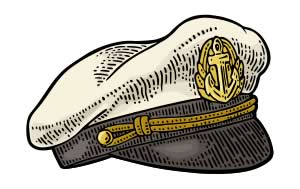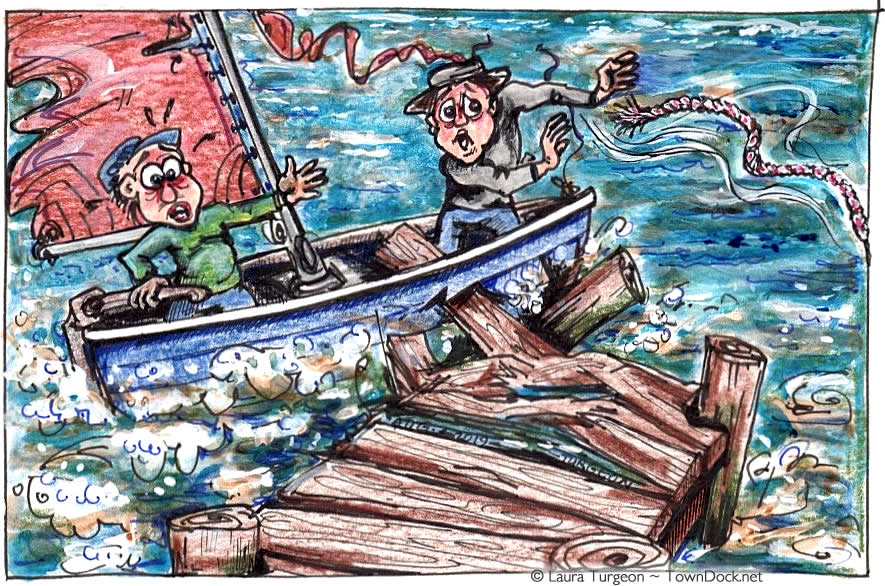It's Friday April 19, 2024
News From The Village Updated Almost Daily

August 2019
Docking. The going and coming must go well. A collision when departing a slip can ruin the entire day. It is difficult to recover from a departure gone bad and still have a good day on the water. Likewise, a collision when returning to the pier can instantly ruin an entire day of fun and relaxation.Granted, docking can be difficult. Each docking event is unique. Even when returning to the same slip, conditions may have changed.
Therefore, it is the process that is most important. The helmsperson and crew must utilize the same technique from situation to situation. Consistent utilization of a like technique or method will make docking routine and stress free.
It doesn’t have to be like this.Here’s the technique that has served me well for many years and, in many different situations. When departing a slip:
- Designate a helmsperson. Only one person drives the boat. Don’t switch duties during undocking.
- The helmsperson stays at the helm and doesn’t help with the lines. The helmsperson is in charge of the undocking event. The helm must be manned at all times.
- When coaching couples, I prefer the human with the most upper body strength to work the lines. The other drives. With that said; type A husbands, if you are going to take charge anyway, you might as well drive. Line handlers, who insist on directing, often ruin the undocking event.
- Start the engine before removing any lines. Do you have oil pressure? Is the raw water pumping? Have a checklist for the navigation equipment, etc.
- At a minimum, check the steering and throttle/transmission. It is best to discover any malfunction before tossing off the lines. Underway not making way is no way to go through life.
- Lines don’t get tossed unless someone is at the helm and is ready. The crew asks the helmsperson before removing any lines. For example – “Are you ready for the port bow line?”
- Make a plan before tossing any dock lines. The plan must be communicated and simple in order to be understood by all. My initial plan for the lines is always:
- Get the lazy lines first. These are the lines without any tension. Usually on the downwind/down current side of the boat. Try to work from forward to aft for a consistent method.
- Remove the most upwind (up current) line last. Remove its partner second-to-last. The most upwind line’s partner is the line keeping the boat aligned in the slip. There should only be two lines on the boat before it moves out of the slip, most likely the upwind/up current bow and stern lines.
- The crew can help the cause by hanging onto an upwind line. The crew can walk an upwind line forward (or aft) as boat moves out of the slip. Keeping tension on this line can prevent the boat from drifting. So, don’t be predisposed to throw off a line the instant it is uncleated. Have some initiative. Help the cause.
- The helmsperson must anticipate, and get ahead of, what is going to happen to the boat. What will the wind do to the boat? Probably push the bow downwind. What is the effect of the current? Be thinking ahead, not reacting. Reacting will be too late.
- The crew must fend off.
- If able, position the dock lines to facilitate your return.
- And remember, as my wife says, “There is plan A, plan B, and what really happens.”
In summary, these steps are the framework for a consistent undocking methodology.
Applying the same consistent technique will reduce the stress associated with departure from a slip. Expectations will be alike. Teamwork will be efficient and you will be on your way to experience the great day on the water you deserve.
Next time, we’ll discuss returning to your slip.
Fair winds,
Captain John
 Captain's Blog on TownDock.net is all about making your time on the water enjoyable. Captain John Rahm teaches sailing and boat handling at Third Wave Sailing. Captain's Blog on TownDock.net is all about making your time on the water enjoyable. Captain John Rahm teaches sailing and boat handling at Third Wave Sailing. |

